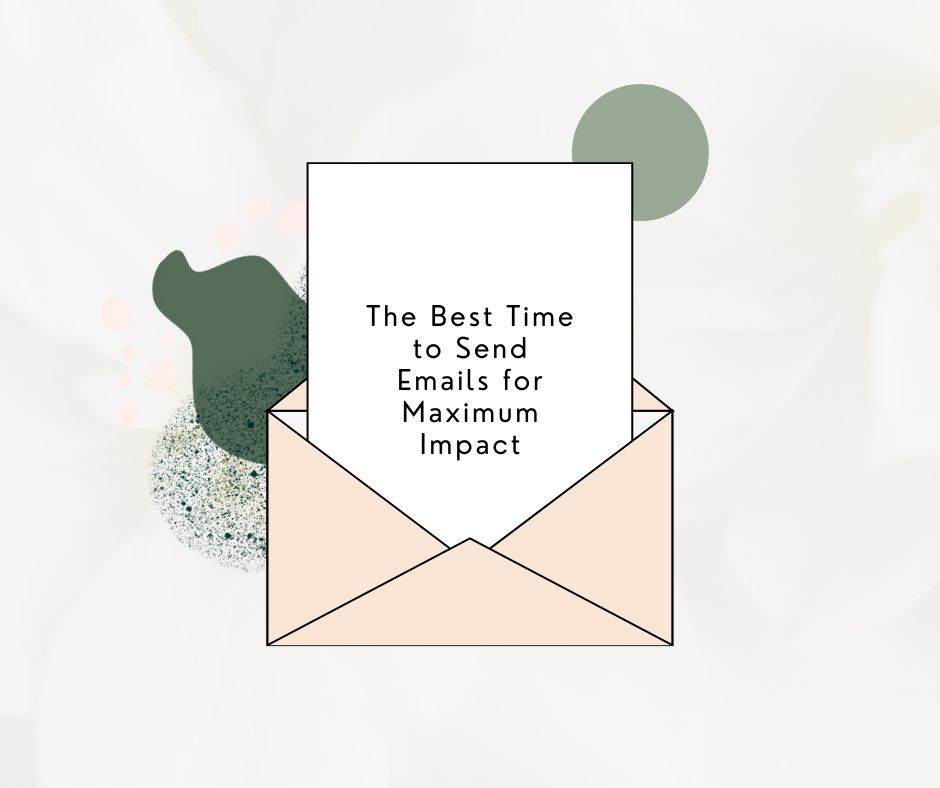Determining the best time to send emails can significantly impact your messages’ open and response rates. However, finding the perfect time can vary depending on various factors, such as your target audience, industry, and the goal of your email. While there is no one-size-fits-all answer, here are a few guidelines to consider when deciding the best time to send your emails.

1. Know your target audience: Understanding your audience’s habits and preferences is crucial. Consider their demographics, time zones, and typical schedules. For instance, if your target audience consists of working professionals, avoiding early morning or late evening might be best when they are less likely to check their emails.
2. Avoid peak hours: Steer clear of the times when people are overwhelmed with emails and are more likely to delete or overlook them. Mornings, especially Mondays, are hectic for many individuals as they catch up with emails after the weekend. Similarly, late afternoons on Fridays may not yield the desired attention. Avoiding these peak hours can increase the chances of your email being noticed.
3. Experiment with different times: Conduct A/B testing to determine your audience’s most effective time. Split your email list into two groups and send the same email at other times. Analyze the open and response rates to identify patterns and trends. This approach allows you to gather data specific to your audience, helping you make more informed decisions.
4. Consider time zone differences: If you have an international audience, it is essential to consider time zone differences when sending emails. Sending an email at a time that aligns with your audience’s local time can increase the likelihood of it being opened and read. Use email marketing tools that allow you to schedule emails based on recipient time zones to ensure maximum impact.
5. Test and optimize: The best time to send emails may evolve as your audience and industry trends change. Continuously test different sending times and analyze the results to identify any shifts in engagement. Pay attention to any emerging patterns or trends and adjust your email-sending schedule accordingly.
6. Consider your email goals: The goal of your email can also influence the best time to send it. For example, suppose you are sending a promotional email with a limited-time offer. In that case, it may be more effective to send it during business hours when people are more likely to make purchasing decisions. On the other hand, sending a newsletter or informational email in the evening when people have more time to read and engage with content may be more beneficial.
In conclusion, there is no one-size-fits-all answer to the best time to send emails. Understanding your audience, considering time zone differences, and experimenting with different sending times is crucial to determine the most effective strategy for your email marketing campaigns. By continuously testing and optimizing your email-sending schedule, you can maximize the impact of your messages and improve your overall email marketing results.
Are any specific days of the week better for sending emails?
When sending emails, timing plays a crucial role in determining their effectiveness. While there is no one-size-fits-all answer to which specific days of the week are universally better for sending emails, some general guidelines can help improve your chances of getting a response.
1. Tuesday: Many studies have shown that Tuesday is often considered the best day to send emails. It is believed that people are more likely to be focused and responsive after getting back into work mode on Monday. Tuesday also allows ample time for recipients to address their urgent tasks from the beginning of the week.
2. Wednesday: Midweek is considered a safe bet for email sending. By now, people have typically caught up with the backlog from Monday and are not overwhelmed with end-of-week responsibilities. It balances between being proactive and not getting lost in the shuffle.
3. Thursday: Thursday is another favorable day for sending emails. It is still early enough in the week for people to have sufficient time and attention to review and respond to emails. Some studies have shown that Thursday emails have a higher open and click-through rate than other days.
4. Avoid Mondays and Fridays: Mondays are notorious for being busy and chaotic as people get back into work mode or catch up on emails from the weekend. Similarly, Fridays tend to be filled with wrapping up tasks and planning for the weekend. Both days may see a higher volume of emails, increasing your chances of getting lost or overlooked in the shuffle. It’s best to avoid sending important emails on these days.
While these guidelines can be helpful, it’s important to remember that every audience and industry differ. It’s essential to conduct your tests and analyze the data to determine the most effective days for your email marketing campaigns.
Is there any research suggesting the best time to send emails?
Yes, research suggests the best time of day to send emails for maximum effectiveness. Several studies have been conducted to analyze email open rates and response rates based on the time of day.
1. Morning: Research shows that sending emails in the morning, particularly between 9 am and 11 am, yields better results. This is because people are likelier to check their emails first thing in the morning when they start their workday. By sending emails during this time, your message will likely be seen and acted upon.
2. Early afternoon: Another effective time to send emails is in the early afternoon, between 1 pm and 3 pm. This is when people have typically returned from lunch breaks and are getting back to work. By sending emails during this time, you can catch people when they are likely to be engaged with their inboxes.
3. Avoiding weekends and late evenings: It’s generally recommended to avoid sending emails over the weekends and late evenings. Many people are less likely to check their work emails during these times, and your message may get buried or overlooked when they do check their inbox later.
However, it’s important to note that the best time to send emails can vary depending on your target audience and industry. It’s recommended to conduct A/B testing to analyze the response rates for different send times and optimize your email strategy accordingly.
Factors such as time zones and cultural differences should also be considered when determining the best time to send emails. If your target audience is in different time zones, you may need to adjust your sending schedule to ensure that your emails are received at a convenient time.
Cultural differences can also play a role in determining the best time to send emails. For example, in some cultures, sending emails during certain hours of the day may be considered inappropriate or intrusive. Knowing these cultural norms and adjusting your sending schedule is important.
In conclusion, while there is research to suggest optimal times for sending emails, it’s important to remember that every audience and industry is unique. Conducting A/B testing and analyzing engagement metrics will help you determine the best time to send emails to your specific audience. By continuously monitoring and adapting your email strategy, you can maximize the effectiveness of your email marketing campaigns.
Is there an optimal number of emails to send out each day?
When it comes to email marketing, finding the right balance is crucial. While there isn’t a one-size-fits-all answer to the optimal number of emails to send out each day, a few factors can help you determine what works best for your audience and goals.
1. Audience preferences: Understanding your audience is key. Pay attention to their behavior and preferences. Monitor open and click-through rates to determine the level of engagement with your emails. If you notice a decline in engagement, it may be a sign that you’re sending too many emails.
2. Content relevance: Quality trumps quantity. Ensure that the content you send is valuable, relevant, and personalized. If you bombard your subscribers with irrelevant emails, they will likely unsubscribe or lose interest. Focus on crafting compelling content that resonates with your audience.
3. Balance frequency: Striking the right balance between staying top-of-mind and avoiding overwhelming your subscribers is important. Sending too many emails daily can be seen as intrusive, leading to unsubscribes or marking your emails as spam. Experiment with different frequencies and monitor engagement metrics to find the sweet spot.
4. Test and analyze: A/B testing is a valuable tool to determine the optimal number of emails for your specific audience. Split your subscriber list into segments and test different sending frequencies. Analyze the results to identify patterns and adjust your strategy accordingly. Remember that what works for one audience may not work for another, so it’s important to monitor and analyze your data to make informed decisions continuously.
In conclusion, no magic number of emails to send out each day guarantees success. It all depends on your specific audience and goals. By understanding your audience, focusing on quality content, and finding the right balance in frequency, you can optimize your email scheduling strategy and improve the effectiveness of your email campaigns. Don’t be afraid to experiment, test, and analyze your data to find what works best for your audience.
If you want to learn more about email and digital marketing strategies for lead generation, contact us today for a free consultation.
Let’s discuss your goals, needs, and challenges and how I can help you overcome them.


Comments are closed